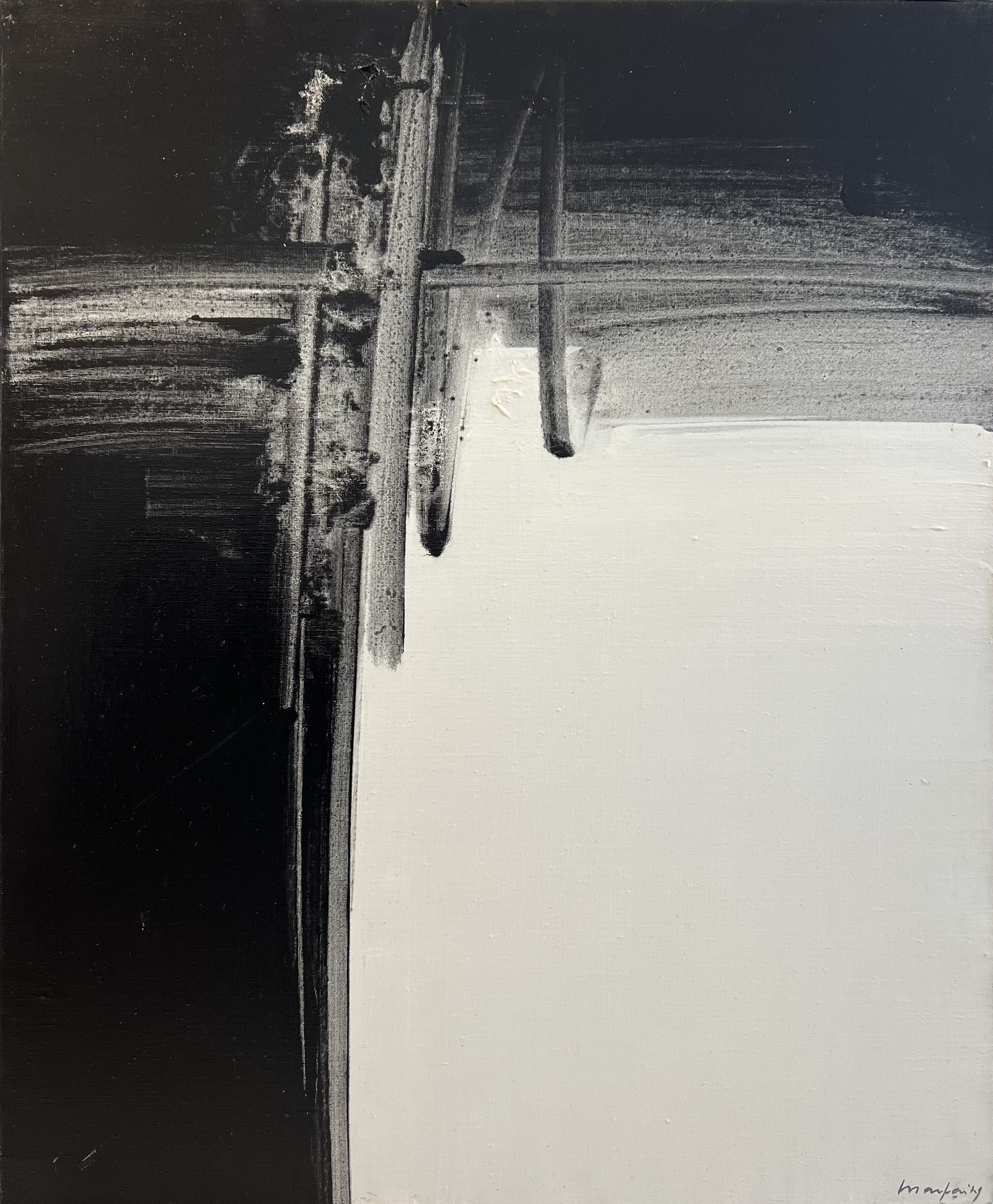André MarfaingComposition
1984
Acrylic on canvas
Signed et dated lower right
28.74 x 23.62 in ( 73 x 60 cm )ZoomInquiry - Composition, 1984
Certificat
Provenance
Galerie Claude Bernard, Paris
Artwork's description
From 1971, André Marfaing abandoned oil paint for acrylic and produced more refined and simplified compositions. Here, the painter brushes the canvas with veracity, firmness and spontaneity. It cuts the space radically, favoring verticality. Black occupies an important part of the composition, like a shadow that covers the light. The white background lets appeaer " the fault where to slip, until gradually invading the space of the canvas, like the quest for an absolute." He is the source of light, revealing, immanent, emerging from his painting. Marfaing has never ceased to question himself, to explore the fight between shadow and light, between emptiness and fullness, between nothing and being. His art is deep and spiritual.
“ Along with Soulages, Hartung and Kline, Marfaing is one of the great crushers of black who appeared after the last war, but he caresses this color with caution, tenderness and firmness. ” Frederic Edelman
Artist's biography
André Marfaing, born on December 11, 1925, in Toulouse and deceased on March 30, 1987, in Paris, was a French artist known for his exploration of abstraction and monochromy. His work, characterized by the predominant use of black and white as well as geometric and gestural forms, marked the French art scene in the second half of the 20th century.
André Marfaing grew up in Toulouse, where he developed an early interest in art. After serving in the French army during World War II, he began studying law before turning definitively to art. In 1949, Marfaing moved to Paris, a hub for artists and intellectuals of the time, where he began to self-train, exploring various techniques and styles.
In the 1950s, Marfaing became associated with the Lyrical Abstraction movement, an artistic trend that emerged in reaction to geometric abstraction, emphasizing spontaneous and emotional expression. He exhibited his first works at the Galerie Arnaud in 1954, and from then on, he began to make a name for himself in the Parisian art scene. His early works show the influence of American abstract expressionism and European informal art, with dynamic compositions and expressive touches of color.
By the late 1950s and early 1960s, Marfaing began to reduce his color palette to focus primarily on black and white. This phase marked a decisive turning point in his career. He developed a unique visual language based on the intense contrast between these two non-colors. His use of black, in particular, became an exploration of light and space, where each stroke and surface carried deep emotional and symbolic weight.
Among the major works of this period, "Composition" (1962) is an emblematic painting of his monochrome style. It features black geometric shapes on a white background, creating a visual effect of depth and movement. Another significant work, "Sans titre" (1965), uses vigorous and gestural brushstrokes, marking the canvas almost violently yet with perfect control.
Marfaing did not limit himself to painting. He also ventured into printmaking and drawing, continuing to explore themes of light and shadow. His prints, such as "Gravure sur bois" (1970), showcase exceptional technical mastery with sharp lines and powerful contrasts.
The 1970s and 1980s saw Marfaing reach full artistic maturity. He participated in numerous international exhibitions, and his works were acquired by renowned public and private collections. In 1971, a solo exhibition at the Musée d'Art Moderne de la Ville de Paris cemented his reputation as one of the leading abstract artists of his generation.
Among his works from this period, "Grand Noir" (1976) is particularly noteworthy. This large-format painting uses deep black planes, interspersed with thin white lines, creating a composition that is both austere and vibrant. "Espace et lumière" (1982), on the other hand, further explores the subtle interactions between black forms and light, achieving a new level of complexity and sophistication in his work.
André Marfaing passed away in 1987, leaving behind a dense and coherent body of work. His exploration of black and white, along with his minimalist yet emotionally charged approach, influenced many contemporary artists. Marfaing succeeded in making black a living and expressive color, capable of conveying a full range of feelings and meanings.
His work is now preserved in several major collections, including the Musée d'Art Moderne de la Ville de Paris, the Centre Pompidou, and numerous international museums. Retrospectives of his work continue to be organized, testifying to the lasting impact of his art on the contemporary art landscape.
